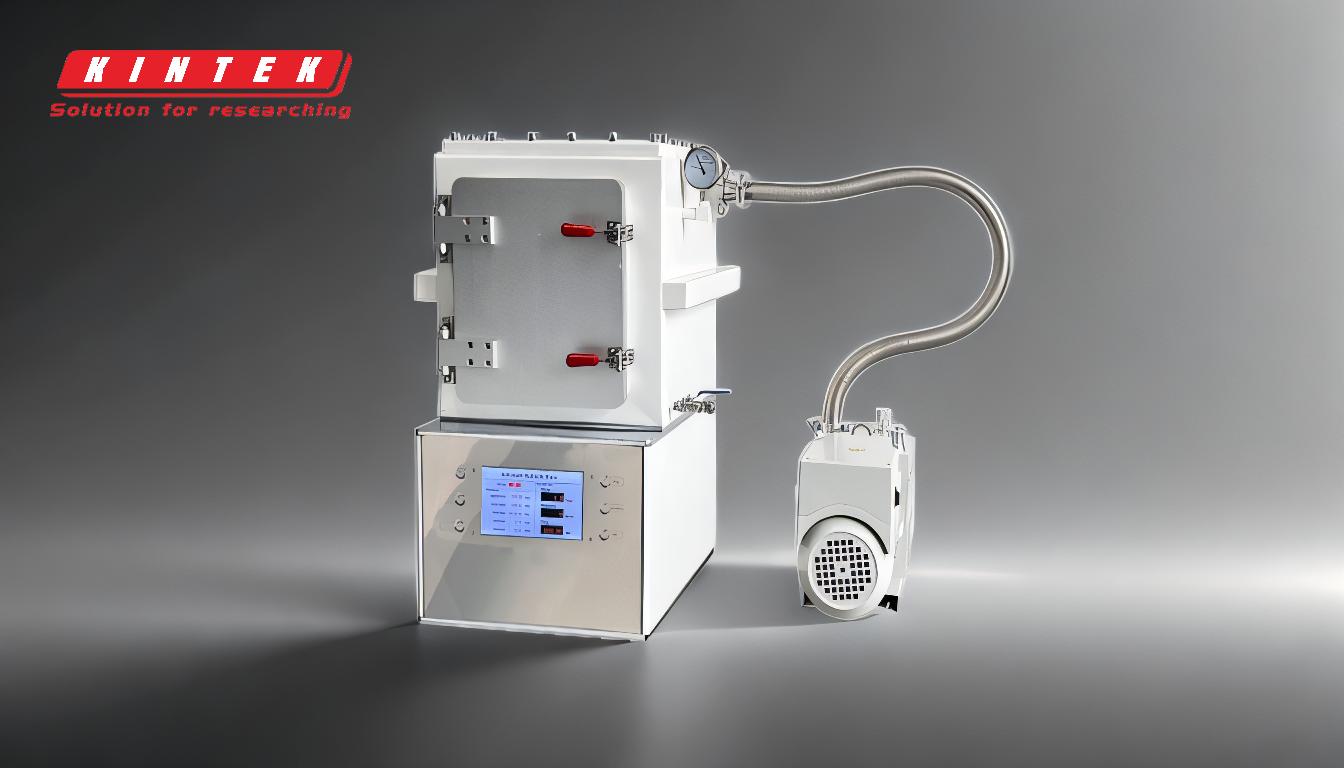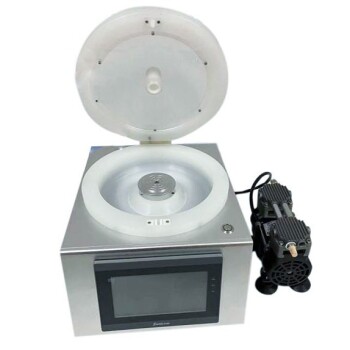At its core, a vacuum coater is a machine that deposits an ultra-thin layer of material onto an object inside a high-vacuum chamber. It works by first creating a near-perfect vacuum to remove all air and contaminants, then vaporizing a solid coating material, and finally allowing that vapor to condense and bond, atom by atom, onto the object's surface.
The essential purpose of the vacuum is to create an immaculately clean, empty space. This allows vaporized coating particles to travel unimpeded from their source to the target object, ensuring a pure, dense, and perfectly adhered film.
Why a Vacuum is Non-Negotiable
To understand how a vacuum coater works, you must first understand why the vacuum itself is the most critical component of the entire process.
Eliminating Contamination
The air around us is filled with particles—dust, water vapor, and various gases. If these particles were present during coating, they would embed themselves into the film, creating defects and weak points.
A high vacuum removes these contaminants, ensuring the deposited layer is exceptionally pure and bonds directly to the substrate material.
Ensuring a Clear Path
The coating process relies on vaporized particles traveling from a source to the object being coated (the substrate). Air molecules would act as obstacles, causing the vapor particles to collide and scatter.
By removing the air, the vacuum ensures these particles travel in a straight, predictable line, which is essential for creating a uniform and consistent coating thickness.
The Two Primary Methods of Vacuum Coating
While the vacuum is the environment, the actual deposition happens through one of two main families of processes: Physical Vapor Deposition (PVD) and Chemical Vapor Deposition (CVD).
Physical Vapor Deposition (PVD)
PVD is a process where a solid material is physically converted into a vapor that then solidifies as a coating on the substrate.
The source material, known as a 'target,' is bombarded with energy inside the vacuum chamber. This is often done via sputtering (using ion bombardment) or a cathodic arc (a high-current electric arc).
This energy transforms the solid target into a vapor or plasma. These vaporized atoms then travel across the vacuum chamber and condense on the cooler substrate, forming a thin, tightly bonded film.
Optionally, a reactive gas like nitrogen or oxygen can be introduced. The vaporized metal atoms react with this gas to form highly durable ceramic coatings, such as titanium nitride.
Chemical Vapor Deposition (CVD)
CVD works differently. Instead of physically vaporizing a solid target, this method uses chemical reactions.
Volatile precursor gases are introduced into the vacuum chamber. The substrate is then heated to a high temperature, which triggers a chemical reaction among the gases on its surface.
This reaction decomposes the gases, causing a solid material to be deposited onto the hot substrate, building the coating layer. Any unwanted gaseous byproducts are pumped out of the chamber.
Understanding the Trade-offs
Both PVD and CVD achieve a similar outcome but have distinct characteristics that make them suitable for different applications.
PVD: Lower Temperatures and Line-of-Sight
PVD is fundamentally a "line-of-sight" process. The vaporized material travels in a straight line, which can make it challenging to evenly coat complex shapes with hidden surfaces.
However, PVD operates at significantly lower temperatures than CVD, making it ideal for coating materials that cannot withstand extreme heat.
CVD: Conformal Coating at High Temperatures
Because CVD uses gases that flow around the substrate, it excels at creating a highly uniform, or conformal, coating over even the most intricate and complex geometries.
The major trade-off is its reliance on very high temperatures to activate the chemical reactions, which limits the types of materials that can be safely coated without being damaged.
Adhesion and Durability
Both methods produce coatings with exceptionally strong adhesion. The atom-by-atom deposition process creates a bond at the molecular level, making the final film extremely resistant to wear and nearly impossible to remove.
Making the Right Choice for Your Goal
Selecting the correct vacuum coating process depends entirely on the material of your part and the desired properties of the final coating.
- If your primary focus is coating heat-sensitive materials or achieving specific optical properties: PVD is often the superior choice due to its lower operating temperatures and precise material control.
- If your primary focus is creating a perfectly uniform coating on complex, intricate shapes: CVD's gas-based nature provides excellent conformal coverage, provided the substrate can withstand the required heat.
Ultimately, vacuum coating is a precise engineering process that fundamentally alters an object's surface properties by depositing a perfectly bonded, high-performance film in an ultra-pure environment.
Summary Table:
| Feature | PVD (Physical Vapor Deposition) | CVD (Chemical Vapor Deposition) |
|---|---|---|
| Process | Physically vaporizes a solid target | Uses chemical reactions of gases |
| Coating Uniformity | Line-of-sight; can be challenging for complex shapes | Conformal; excellent for intricate geometries |
| Operating Temperature | Lower temperatures | High temperatures required |
| Ideal For | Heat-sensitive materials, precise optical coatings | Complex parts that can withstand heat |
Ready to enhance your products with high-performance coatings?
KINTEK specializes in lab equipment and consumables, providing advanced vacuum coating solutions for your laboratory needs. Whether you require the precise control of PVD or the uniform coverage of CVD, our expertise ensures you achieve superior surface properties, durability, and performance.
Contact our experts today to discuss how our vacuum coating technology can solve your specific application challenges.
Related Products
- Inclined Rotary Plasma Enhanced Chemical Vapor Deposition PECVD Equipment Tube Furnace Machine
- HFCVD Machine System Equipment for Drawing Die Nano-Diamond Coating
- 915MHz MPCVD Diamond Machine Microwave Plasma Chemical Vapor Deposition System Reactor
- Vacuum Hot Press Furnace Machine for Lamination and Heating
- Laboratory CVD Boron Doped Diamond Materials
People Also Ask
- What is plasma enhanced chemical vapor deposition? Achieve Low-Temperature, High-Quality Thin Films
- What is plasma enhanced chemical vapour deposition process? Unlock Low-Temperature, High-Quality Thin Films
- What is meant by vapor deposition? A Guide to Atomic-Level Coating Technology
- What is the difference between CVD and PECVD? Choose the Right Thin-Film Deposition Method
- What is plasma in CVD process? Lowering Deposition Temperatures for Heat-Sensitive Materials




















